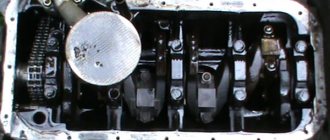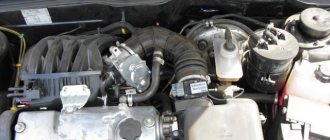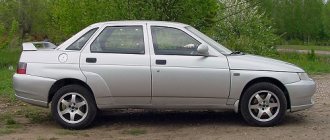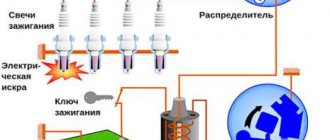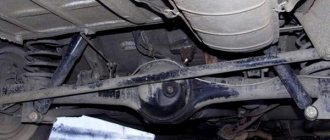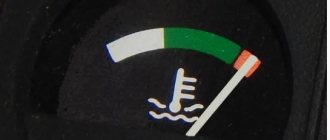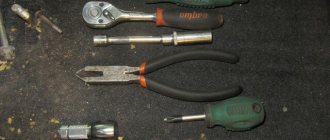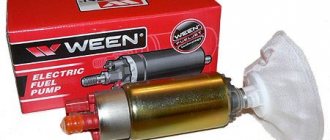Technical specifications
The VAZ 2110 engine has high performance. At the same time, several variants of power units from AvtoVAZ were installed on the vehicle during the production process. The “Ten” had in its arsenal both a simple eight-valve engine and a sixteen-valve version.
Let's look at the main technical characteristics of the VAZ engines with which the 2110 model was equipped:
VAZ 2111
| Name | Index |
| Volume | 1.5 liter (1499 cm3) |
| Number of cylinders | 4 |
| Number of valves | 8 |
| Fuel | Petrol |
| Injection system | Injector |
| Power | 77 hp |
| Fuel consumption | 8.2 l/100 km |
| Cylinder diameter | 82 mm |
The VAZ 2110 1.5 liter engine was highly popular due to its simplicity of design, as well as easy maintenance and repair. In 2004, more than 1,000,000 vehicles with such characteristics were sold in the Russian Federation, and almost 250,000 models in Ukraine.
VAZ 21114
| Name | Index |
| Volume | 1.6 liter (1596 cc) |
| Number of cylinders | 4 |
| Number of valves | 8 |
| Fuel | Petrol |
| Injection system | Injector |
| Power | 81.6 hp |
| Fuel consumption | 7.6 l/100 km |
| Cylinder diameter | 82 mm |
8 valve VAZ 2110 engine, which is also used in the Samara 2 series of vehicles. The engine capacity is 1.6 liters. The model gained popularity due to its higher power and reduced consumption.
VAZ 21120
| Name | Index |
| Volume | 1.5 liter (1499 cm3) |
| Number of cylinders | 4 |
| Number of valves | 16 |
| Fuel | Petrol |
| Injection system | Injector |
| Power | 93 hp |
| Fuel consumption | 7.0 l/100 km |
| Cylinder diameter | 82 mm |
Not a very popular version of the power unit. Although the engine power is high, as practice has shown, this engine did not take root on the VAZ 2110, since it had a number of design flaws. Basically, the engine was installed on a car marked VAZ 21103.
VAZ 21124
| Name | Index |
| Volume | 1.6 liter (1599 cc) |
| Number of cylinders | 4 |
| Number of valves | 16 |
| Fuel | Petrol |
| Injection system | Injector |
| Power | 89.1 hp |
| Fuel consumption | 7.0 l/100 km |
| Cylinder diameter | 82 mm |
A sixteen-valve version of the power unit, which received almost 100 horsepower and had high technical characteristics.
As practice has shown, the most popular among car enthusiasts was the VAZ 2110 8-valve engine marked 21114. But here is a modification of the car marked VAZ 21103, on which a 16-valve one and a half liter engine was installed.
The average lifespan of a Lada engine is 250,000 km. If you use high-quality oil in the VAZ 2110 engine, you can increase the service life of the power unit by 20-30 thousand km.
Prices for VAZ 2110 2111 2112 21124 engines on the secondary market (2020)
VAZ 2112 21124 16 valve engines, characteristics, maintenance
In 1997, the VAZ 2112 saw the light of day - it was the first serial AvtoVAZ 16-valve engine with two camshafts. Its volume was the usual 1.5 liters, it produced 92 horsepower with 130 Nm of torque. It was first installed on the Lada 2110, but the following year, 1998, the Lada 2112 started with it, and in 2000 it was also installed on the Lada 2113.
The VAZ 2112 engine was used by the concern for about 7 years. In 2004, a new generation VAZ engine began to be installed on the Lada 2110 - VAZ 21124. Which became 100 mm larger, slightly more powerful and more environmentally friendly (the main difference from its predecessor was an improved catalytic converter and new, individual ignition coils). Now Lada cars with a VAZ 21214 engine passed Euro 3 environmental standards (after modifications to the catalytic converter, and Euro 4). The VAZ 21214 engine lasted on the assembly line almost twice as long as its predecessor - from 2004 to 2013 and was installed on: Lada 2110, Lada 2112, Lada 2111, Lada Samara hatchback, Lada Samara Coupe.
Service
VAZ 2110 engines are serviced quite typically. Thus, scheduled maintenance is carried out within 10-15 thousand kilometers. If the vehicle is operated on LPG, then maintenance must be reduced to 8-10 thousand km in order to preserve the engine and extend its service life.
When servicing, it is necessary to pour only high-quality oils into the VAZ 2110 engine. Thus, there are a number of lubricating fluids that must be poured into the engine.
Do not forget about using a high-quality oil filter, which will also affect the service life. The power unit maintenance scheme is quite simple, and is provided by AvtoVAZ in the repair manuals.
The VAZ 2110 8 valve engine is quite unpretentious in the use of oil. So, both semi-synthetic and synthetic lubricant are ideal for him. Many car enthusiasts ask the question: how much oil should be poured into the engine? Almost all engines require 3.5 liters of oil.
The VAZ-2110 family in detail. Fight of opposites
The VAZ-2110 family in detail. Fight of opposites
1995
Start of production of the VAZ 2110 sedan. Engines - petrol, P4, 8-valve 1.5 l, 51 kW/69 hp. and 53 kW / 72 hp Gearbox - M5, front-wheel drive. 1996–1997 New modifications of the 1.5 liter engine, differing in power and environmental performance.
1998 Production of the VAZ 2111 station wagon has begun. Some vehicles are equipped with a new 16-valve engine model 2112 - 1.5 l, 69 kW/94 hp.
1999 Production of the 5-door hatchback VAZ 2112 has begun.
2004 Some cars are equipped with new petrol engines VAZ 21114 - P4, 1.6 l, 60 kW/81 hp. (8-cl.) and 21124 - 72 kW/100 hp. (16th grade).
Cars of the “tenth” VAZ family are top sellers, and there is good demand for them in the secondary market.
At the same time, many buyers are wary of them. The opinions of the owners are contradictory: some praise VAZs for their reliability and low cost of maintenance, others dream of getting rid of the crumbling “constructor” almost for nothing. It is beneficial for roadside services to maintain the reputation of a “car kit”: “We will change the parts, but the car will not become better” - what kind of demand are they saying from us!
Let’s figure it out together whether it’s worth buying a used VAZ 2110, 2111 and 2112, what to look for when buying and what costs to expect in operation.
BY LOVE AND BY CALCULATION
From a formal point of view, the “ten” is a completely modern product, no matter what they say about the design, ergonomics and quality of finishing materials. It turned out that even Europeans are ready to turn a blind eye to assembly flaws when they are offered a comfortable and dynamic family car, economical and environmentally friendly, at half the price of a Western classmate. Yes, so far the “tens” do not have ABS or airbags, but not all “foreigners” enter the Russian market with such equipment. Let's be realistic.
Perhaps one of the main trump cards of these cars is low fuel consumption. Six liters per hundred outside the city is by no means a record. Another equally important advantage is maintainability (primarily this applies to 1.5 liter eight-valve engines) and relatively low demands on fuel quality.
Note that both the catalytic converter and the lambda probe work here even longer than on other foreign cars.
But not everyone buys these cars to save money. Quite the opposite: they install “sports firmware”, a “zero” filter, throw out the neutralizer and “ignite” in full. Well, the “ten” is really a good object for tuning. There is something to improve here, especially in terms of handling, and considerable experience has been accumulated in fine-tuning it, including to a full-fledged sports car. Spare parts are much cheaper than for a foreign car, so the cost of a mistake is much lower.
Finally, the third group is “dacha residents”. The VAZ 2111 has no competitors in its price niche. For the “body” in the rear, you can forgive the poor view through the glass of the fifth door, the noisy upholstery, and the gasoline smell in the cabin. Fortunately, it is not that difficult to get rid of - just remove the two-way valve in the gas tank cap (sooner or later it fails on many cars).
EIGHT OR SIXTEEN?
Carburetor cars with an eight-valve 1.5 liter are rare on the market today. However, for a remote province, where there is no good diagnostician with a scanner for a thousand miles in the area, this is perhaps the only acceptable option. The engine is almost identical to the VAZ 2108, many of their parts are interchangeable.
An option for a more civilized province is a “ten” with an injection engine without a converter and a lambda probe. However, to adjust the CO, you will need a gas analyzer, and you cannot check the remaining elements of the control system by eye. However, most sensors can be checked with a regular autotester, but without special knowledge the device will not help.
The most popular engine is an eight-valve 1.5 liter with a converter. It is quite sufficient for “non-sports” driving, and it has many advantages over a sixteen-valve engine of the same volume. The main thing, perhaps, is that if the belt breaks, the valves do not suffer. This is probably why it is prescribed to change it one and a half times less often. Another headache for owners of sixteen-valve “ten” cars is hydraulic valve clearance compensators. They often fail during the warranty period (100 thousand km). Sometimes the defect is in the part itself, sometimes low-quality oil is to blame. In any case, this engine requires good service.
“Dozens” with new 1.6 liter engines have been produced for only a year, so there are almost no of them on the secondary market, and there is little operating experience. Let us only note that there is no need to worry about timing belts here. In the event of an early break, you will only have to spend money on a new belt and a tow truck - the engine will remain intact.
The service life of one and a half liter engines before replacing the rings is on average about 120 thousand km (and mainly only the oil scraper rings wear out). Hone marks in the upper part of the cylinder bore usually also disappear by this mileage, but the wear is small, less than 0.05 mm per diameter. It is worth boring the block when the second set of rings wears out, up to 200 thousand, or even after the third set wears out - there are happy exceptions. With good oil, the crankshaft and bearings last at least 300 thousand km.
In practice, valve clearances need to be adjusted approximately every 100 thousand km, but provided that the original parts were not hammered. The times of the “quiet”, rustling engines of the early 90s are over, but the peak of marriage, it seems, is also behind us. The most problematic engines are those produced in 2002–2003. The axes of the valve bushings, holes for the cups in the cylinder heads and seats often did not coincide, the parts warped, knocked, and wore out.
The valve discs burned out, and sometimes the piston caught up with the skewed valve stuck in the bushing and broke the disc in half.
There were also problems with the piston: it happened that in cylinders of the same class there were pistons branded with four different letters. It’s really time to send workers off the assembly line to learn the alphabet!
Today, the most common disease is a misaligned timing belt (the magazine has written about this several times). Let’s add just one to the previous tips: check the condition of the drive gear on the crankshaft. Often, after replacing it, the distortion disappears.
Engine control sensors and actuators are generally reliable. The majority of failures occur in the mass air flow sensor (MAF) and the idle air controller (IAC). The reason is simple - contamination of the nodes. The main symptom: the idle speed rises to 1200–2000 rpm, becoming unstable. A faulty air flow sensor usually increases fuel consumption. To extend its life, it is worth moving the hose of the large crankcase ventilation branch closer to the throttle valve, and the performance of the IAC can often be restored by washing it with “Carburetor Cleaner”. Just don’t forget to lubricate the regulator mechanism - the unit won’t last long if it’s dry.
Motor repair
A major overhaul of a VAZ 2110 engine means restoring the engine and its components to factory standards. This operation is carried out when the motor has passed its service life and there is exhaustion in the main components.
Due to the fact that the engines have been in use for a long time, some engines are 10-15 years old, a major overhaul is inevitable. So, the combustion chambers have already worn out, and the pistons have burned out from service life and mileage. In addition, engine oil for the VAZ 2110 no longer helps to maintain performance to such an extent.
So, it is worth repairing the power unit at a car service center, especially with regard to the 16-valve engine. The VAZ 2110 8-valve engine is used by most motorists in garage conditions, since it has a simple design that is similar to the Classic and Samara power units.
Modifications
The standard VAZ 2110 contains new developments and some features.
The first car was completely carburetor and 8 valve. This system had a volume of 1.5 liters and made it possible to develop about 70 horsepower.
This potential was enough to get real pleasure from movement. As for the maximum speed, it varies within 160 kilometers per hour.
After the carburetor engine, the designers decided to make an injector (already 16 valve). Essentially, these are the same 1.5 liters of volume, but with slightly increased engine power to 79 horsepower. This move made it possible to improve dynamism and increase maximum speed.
Until the 90s, the vehicle had a rather sparse interior and exterior. The designers made the car as a means of transportation, not a luxury. Only after the 90s were customers able to get a spacious trunk, comfortable seats, an adjustable steering wheel, air conditioning, and so on. Over the entire production period of the VAZ 2110, a huge number of modifications of its engine were developed: both an 8-valve carburetor and a 16-valve injector.
Frequently asked questions and answers
Many car enthusiasts on forums and websites often ask the same questions. Having grouped the main ones, we will try to give answers to the most interesting ones.
- Do valves bend in a VAZ 2110? - Of course, it’s oppressive. Failure to promptly replace the timing belt can lead to its rupture. After this, bent valves and a major overhaul of the block head will necessarily follow, and maybe not only that.
- Where is the engine number on the VAZ 2110? — The engine number is stamped on the shelf of the cylinder block under the thermostat. It's easy enough to find.
- How much oil is in the 2110 engine? — The recommended oil volume for VAZ 2110 engines is 3.5 liters. So, when replacing, it is necessary to keep the indicator on the dipstick from minimum to maximum. Too little liquid or too much can lead to consequences.
- Which oil is better to use in the 2110 engine? — VAZ 2110 oil must be filled with the one recommended by the manufacturer. Lubricants recommended for the engine by AvtoVAZ are listed in the table below.
- What is the operating temperature on the 2110 engine? — The operating temperature of the VAZ 2110 engine, regardless of modification, is 87-103 degrees Celsius. Thus, high temperature or a malfunctioning VAZ 2110 engine cooling system can lead to overheating of the engine, and subsequently to repair of the main structural elements.
2.0 liters, injector
It was not at all necessary to perform complex engine tuning or organize chip tuning in order to increase the power and characteristics of the engine. This is because AvtoVAZ released a limited edition of the VAZ 2110 model, under the hood of which there was an interesting, unusual engine.
Under the hood of the limited ten there was an engine manufactured by Opel. Its power is 150 horsepower.
In addition to this German power unit, development of a rotary piston engine was carried out.
Alas, both engines, for unknown reasons, never received the popularity they deserved. Although, given the external data of the “ten”, its technical capabilities, the presence of 150 horses under the hood today would please a huge number of young drivers who cannot afford to buy an expensive car.
Carburetor and injection engines with 8 and 16 valves, developed and installed on the VAZ 2110, have their own advantages, features, and disadvantages. Among them there are literally a couple that turned out to be really successful.
But with proper handling, proper care and quality repairs, any of the presented motors can serve for a long time and reliably.
Source
Tuning and modification
Recently, it has become popular to tune the VAZ 2110 engine. Many motorists turn to a tuning studio to carry out the engine modification procedure.
What can you do with the power unit? The tuning scheme is quite simple. Mechanical (boring) and electronic (chip tuning) modifications are carried out. Of course, many car owners only chip the engine to reduce consumption or increase power.
Mechanical modification of the power unit involves boring the cylinder block and installing lightweight spare parts. Thus, pistons and valves manufactured by API are installed. The best guide bushings are those from K-line Corporation. As for the guide bushings, there is no need to knock out the old ones, since you can install bronze sleeves that will lighten the weight of the motor.
After mechanical modification, you can no longer fill in ordinary lubricating fluid. Therefore, only high-quality oil for the VAZ 2110 is poured into the tuning version.
After mechanical modifications are completed, an auto electrician comes into play and adjusts the operation of the motor. This could be a regular firmware update of an old engine control unit or a chip installation. For the brains that are installed on VAZ 2110 engines, there is a soldered-in chip or an external connection.
About LADA 2110 engines 1st generation (1995 - present)
The VAZ 2110 (Lada 110), popularly called the ten, is a front-wheel drive sedan, in the design of which the components and assemblies of the VAZ 2108 were used. With the VAZ 2110, a new, tenth VAZ family began. In particular, the family is represented by the VAZ 2111 station wagon and the VAZ 2112 hatchback. Until 2007, the VAZ 2110 was produced at AvtoVAZ production facilities, then production was transferred to other factories, where the car was assembled until 2014.
Compared to its predecessors, the VAZ 2110 has a more modern appearance and design, and has greater comfort. In this article we will look at the engines installed on the VAZ 2110, their characteristics and the most common faults.
ENGINE VAZ 11183/21114
Engine 21114, which has a second index of 11183, is a development of the ideas laid down by the 2111 1.5 liter power unit. and directly, 083 motor. The engine has a taller cylinder block, increased piston stroke, and a volume of 1.6 liters. The engine has improved environmental performance and greater reliability. Compared to VAZ 2111 engines, the VAZ 11183 unit is less capricious, more elastic and high-torque. If we compare these two engines, it should be noted that although they are assembled at the same plant, they are assembled on different lines.
Conclusion
A wide variety of engines were installed on VAZ 2110 vehicles - from 8 to 16 valves, but the engine volume did not exceed 1.6 liters. The engines have shown themselves to be positive, having high technical characteristics and service life.
Simple maintenance and repairs have made power units beloved by many motorists. You can carry out a major overhaul of the internal combustion engine in the garage; in this case, you only need to bore the cylinder block to repair size at a car service center.
1.6 liters, injector. 8 and 16 valves
This engine is found today in almost all VAZ 2110 that can be found on sale. There are two versions that differ slightly in characteristics and have 16 and 8 valves respectively.
The basis for the creation of these engines was a 1.5 liter unit.
The secret to the engine's success turned out to be quite simple. The engineers simply increased the piston stroke by a few millimeters and also made the height of the cylinder block higher by 2.3 millimeters, leaving the diameter of the cylinder and piston the same.
To prevent the valves from breaking, special recesses were provided in the pistons. This allows them not to bend if the timing belt breaks.
Characteristics
Characteristic
Indicators
1596 cubic centimeters
Average fuel consumption
7.5 liters per 100 km
7.2 liters per 100 km
Rarely encountered types of breakdowns
If all of the above does not bring the desired effect, you need to look further for the reason.
With a high probability it can be said that the VAZ 2110 8-valve injector became a victim of a malfunction of the gearbox. Under significant loads, they wear out much faster. With regular maintenance, the VAZ 2110 engine works properly, but if such inspections are irregular, troubles can occur with the VAZ 2110 16 valves. If the technical inspection does not help eliminate problems with the car engine, all gearbox parts are checked manually.
It is designed in such a way that if just one part breaks slightly, the entire device stops functioning. An in-depth inspection will help revive the VAZ 2110 16 valves. Various breakdowns occur with VAZ engines, but they can be identified and eliminated in 2-3 hours. If, after the specified period, the VAZ 2112 device has not revealed the secret of the breakdown, it is easier to replace the gearbox.
Much less often, incorrect tuning of the “iron horse” should be blamed. When installing additional elements not provided for in the original configuration on the motors, the system's tightness may be compromised. In second place is the environmental problem. The increased volume of passing air carries more particles of dust, dirt and chemical elements that clog the system.
The engine injection system has improved the performance of the VAZ model range. At the same time, the driver is forced to pay more attention to the technical condition of the “iron horse,” which will reduce the likelihood of downtime due to breakdown.
Restoring the car's performance
The attention of the car owner is the key to the health of the “iron horse”. The lack of engine response to turning the ignition key in the system indicates problems, first of all, with the injector. The initial inspection begins with a visual examination. VAZ 2110 injector 16 valves should not have any visual damage or chips. For inspection, use tools to carefully remove the motor fitting cover.
Immediately after removing the spool, you should check the correct operation of the engine. In normal condition, VAZ engines are characterized by pressure gauge readings ranging from 2.8 to 3.2 atm. If the actual reading is below the specified value, the motor needs an in-depth check. There is a high probability that the cause of the malfunction lies in the flexible pipe.
In the normal state of the VAZ 2110, the 8-valve injector is completely sealed. If a check in a garage or service station did not help identify the location of the depressurization, the broken motor needs to replace the failed unit. It is more difficult if the pressure gauge readings are higher than the specified values. In this case, a 16 valve engine or its equivalent needs to replace the starter. The action plan is as follows:
- remove the traction relay;
- unscrew 2 bolts with a 13 key;
- remove one nut; if motors have not been professionally worked on for a long time, then this procedure becomes somewhat more difficult; Increased physical effort will help weaken the thread; however, you don’t need to try too hard, otherwise the 16 or 8 valve engine will fail;
- remove the starter housing;
- check the brushes - the most vulnerable element; An 8 or 16 valve engine often fails precisely as a result of a violation of the integrity of the mentioned brushes. Minimal damage detected on them is a reason for immediate replacement. There is no need to delay this procedure.
Much less often the cause of a malfunction is a clogged gearbox. The standard 8 valve injector is characterized by increased sensitivity to external pollutants.
Thorough cleaning of the gearbox significantly reduces the likelihood of problems with the motor.
Prevention measures
A huge portion of breakdowns can be avoided if you treat your own car accordingly. Yes, no one excludes unforeseen situations, but simple preventive measures should definitely become the norm for you when handling your car:
- Constantly check the coolant level in the reservoir and top up if necessary;
- For your VAZ 2110, do not skimp on high-quality coolant;
- Do not use plain water as a coolant, as it has a lower boiling point and promotes scale formation and corrosion inside the cooling system;
- Always look at the readings of the coolant temperature sensor located in the cabin. Avoid situations where the arrow crosses the red line.
It is obvious that the CO is the most important unit in the engine compartment, the efficiency of which determines the condition, performance of the engine and more.
Therefore, it is extremely important to treat the cooling system with care, monitor its condition, and take timely actions to eliminate any malfunctions that arise.
Loading …
Rarely encountered types of breakdowns
Engine valve adjustment 4216
If all of the above does not bring the desired effect, you need to look further for the reason. With a high probability it can be said that the VAZ 2110 8-valve injector became a victim of a malfunction of the gearbox. Under significant loads, they wear out much faster.
With regular maintenance, the VAZ 2110 engine works properly, but if such inspections are irregular, troubles can occur with the VAZ 2110 16 valves. If the technical inspection does not help eliminate problems with the car engine, all gearbox parts are checked manually.
It is designed in such a way that if just one part breaks slightly, the entire device stops functioning. An in-depth inspection will help revive the VAZ 2110 16 valves. Various breakdowns occur with VAZ engines, but they can be identified and eliminated in 2-3 hours. If, after the specified period, the VAZ 2112 device has not revealed the secret of the breakdown, it is easier to replace the gearbox.
Much less often, incorrect tuning of the “iron horse” should be blamed. When installing additional elements not provided for in the original configuration on the motors, the system's tightness may be compromised. In second place is the environmental problem. The increased volume of passing air carries more particles of dust, dirt and chemical elements that clog the system.
The engine injection system has improved the performance of the VAZ model range. At the same time, the driver is forced to pay more attention to the technical condition of the “iron horse,” which will reduce the likelihood of downtime due to breakdown.
